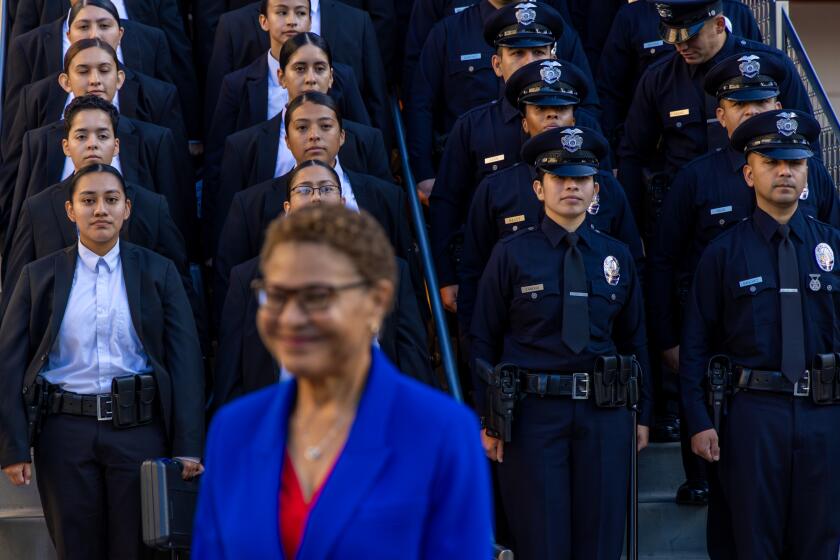
- Share via
- One month later, two wildfire experts argue that the destruction didn’t have to be as bad as it was.
- If we think of fire as a part-time seasonal phenomenon, our strategies for fighting fire will continue to fail.
- The question isn’t whether we can live with fire but how we can live with it.
Soon after catastrophic fires swept through Pacific Palisades and Altadena, wildfire experts Stephen Pyne and Jack Cohen were in high demand. Respected for their historical and scientific expertise, they provided commentary and perspective.
Although neither live in California, they are familiar with its topography, its devil winds and hillsides ready to combust, and their message was clear. As tragic as these fires were, the greater tragedy is that they didn’t have to be this bad.
“The astonishing thing is not that Los Angeles burns but that so much of its development has enhanced rather than blunted the threat from fire,” Pyne wrote last month.
Currently a professor emeritus at Arizona State University and living outside of Phoenix, Pyne is the author of numerous books that explore the cultural role that fire has played shaping human history.
Cohen, a retired research scientist with the U.S. Forest Service, is an authority on the dynamics of home ignition and has worked with the Missoula Fire Sciences Laboratory in Missoula, Mont., where he lives.
“Uncontrollable extreme wildfires are inevitable,” he wrote five years ago, “however, by reducing home ignition potential … we can create ignition resistant homes and communities.”

Frustrated by the continual ineffectiveness of firefighting efforts over the decades, both advocate for a more sophisticated understanding of fire and the ecosystems that foster urban and wildland blazes. Fire is so often viewed as a crisis and emergency that it is divorced from many factors that contribute to its destructive nature — factors that, if addressed, could mitigate the destruction.
This interview with Pyne and Cohen has been edited for length and clarity.
Many scientists point to climate change as the primary factor for these explosive fires. But you see it differently.
Stephen Pyne: I don’t have any doubt that global warming is putting energy into the system in ways that are generally aggravating these fires. But America’s cities from the 18th century on burned as often because towns were made of the same materials as the countryside — and burned amid the same winds and droughts. Then in the 1960s and 1970s, we had a national fire problem, which required federal agencies to revise their fire policy. All of this was before climate change. This was simply because of land use and fire practices.
Eaton and Palisades fires
The devastating fires killed at least 28 people, destroying and damaging more than 18,000 buildings valued at more than $275 billion and leaving a burn zone 2½ times the size of Manhattan.
Climate is clearly a serious contributor, but this latest outbreak would not have been as bad if we had listened to what we learned over the last century that had tamed urban wildfires: rigorously enforced fire and building codes; zoning that breaks up large sweeps of fuel; installing a fire protection system adequate to the actual risks; creating an environment in which insurance could function. These reforms, ultimately political, are what caused urban fire to fade across the country. It’s as though, having all but exterminated a plague, we decided we no longer needed to keep up the pyric hygiene that contained it.
Jack Cohen: As Steve said, fire is a sociological issue, and climate change has become a critical part of the discussion, but we had these problems well before climate change. Fire is essentially a physical phenomenon, and these fires represent a physical problem. Pacific Palisades and Altadena burned because of an ignition problem, not because of climate change. Communities burned because homes caught fire. It is that simple.
For years, renowned fire experts Jack Cohen and Stephen Pyne have tried to shift the conversation on fire prevention strategies. This week’s destruction, they say, could have been minimized.
The fires are described as unprecedented. What does the historical record show?
Pyne: Calling the January fires “unprecedented” doesn’t get us anywhere. We’ve been through urban fires, and we fixed it. For example, after the Berkeley fire in 1923, wood shingles were banned on new construction around the Bay Area. They were generally viewed as hazardous, but then in the big postwar housing boom, particularly in Southern California, wood shingles came back. Reforms have followed bad fires, but they tend to be piecemeal, a city here, a city there, and most often too late, and almost always reactive.
Cohen: These fires were unprecedented because they occurred in January and because it didn’t rain that month and there was an ignition. We’ve had similar catastrophic fires in the fall, like the 2017 Tubbs fire that destroyed the Santa Rosa neighborhoods of Coffey Park and Fountaingrove in October and the 2018 Camp fire that initiated destruction in the town of Paradise in November.
How do you think these fires could change the discussion about fighting fires?
Pyne: The question I’m being asked but don’t quite know how to answer is when does the pain become enough that we actually have a serious conversation and address the fundamental issues, which are more about changing the fuels that houses provide to fire than devising new technologies to suppress outbreaks once they are blowing through cityscapes. I would like to think that these recent fires might be horrific enough to serve as a catalyst, but I’ve thought that for a couple of decades as urban conflagrations have built up in magnitude and damages.
What disturbs me the most is that I’m struggling to find the mechanism by which we can come together and have a serious discussion in a coherent way and decide collectively what we need to do. But we haven’t reached that point yet. I think it’s a failure of politics. I think it’s a collapse of our ability to come to a consensus that is accepted as legitimate. Fire spreads much like a contagion. It requires a collective response. I’m not sure we have an adequate process for mustering the necessary social wherewithal.
Cohen: Like Steve, I would like to think the high visibility of the Palisades and Altadena destruction will stimulate a quest for change. But what’s most frustrating about another community disaster is the dominating social perception of the wildfire threat — whether from firefighting agencies, the public or politicians — that has historically become a major obstacle for living with the inevitability of wildfire. Our language dramatically vilifies wildfires. It becomes “explosive.” It “vaporizes homes in its path.” How can we possibly live compatibly with wildfire when it is cast in such apocalyptic terms?
The dramatic hyperbole of our language describing wildfires is not matched by the mundane reality of how homes and structures ignite during extreme wildfires. The research I and others have done identifies lofted burning embers as the principal source for starting numerous, simultaneous small ignitions within the community. A home’s ignition vulnerabilities — in relation to burning embers and burning materials surrounding the home — lead to destruction. Reduce that vulnerability and you reduce community ignition potential.
Unfortunately this message is ignored especially and undermined when the head of the Forest Service goes before Congress raising expectations of wildfire control by saying the agency suppresses 98% of the fires with the full implication that suppression is possible. The problem with that, of course, is all of our major community wildfire risk problems are in the uncontrollable 2%.
As a result, we end up feeling like victims of fire, and victimization will be an obstacle to problem-solving.
Los Angeles County keeps building in hillsides and canyons even as the fire risk worsens. For a century, the lure of development in natural surroundings has won out.
How can we begin to start thinking about fire in a more constructive way?
Pyne: Part of the prevailing narrative, at least in the fire community, is that we really know enough about fire and that it’s the public and politicians who have to be educated. But every potential community — social, economic, political, intellectual, scientific — looking at this problem has misdefined it in a way. We’re struggling to come up with a proper definition of what it is.
Fire is a systemic issue — touching on ecology, politics, sociology — and we are just not prepared to understand it that way. So we still treat it as a part-time seasonal phenomenon, an occasional emergency.
Cohen: What most people think they know about fire is wrong. Typically people consider wildfire as a thing rather than a process. A few years ago, a fire in Colorado was described as a “300-foot-high tsunami of flame.” Fire doesn’t spread that way. It spreads only if specific ignition and combustion requirements are met, and unfortunately most homes meet those requirements. We pay more attention to visible flames — that tsunami — than we do to the principal structure ignition mechanism: burning embers.
Many agencies, certainly federal agencies, assume that fire intensity determines community wildfire risk. But fire intensity has nothing to do with structure ignition vulnerability — how a home ignites. Yet still they focus on maintaining low fuel loads — brush abatement, forest thinning — which would burn at a lower intensity but still lead to an uncontrollable extreme wildfire. When our agencies, institutions and politics recognize we have no choice in controlling inevitable extreme wildfires, and recognize that community wildfire risk is a structure ignition problem, then we can create ignition-resistant, fire-spread-resistant communities.
The road to recovery is going to be long. Do you see any glimmers of hope along the way?
Pyne: What I’m carrying away from our present conversation is that maybe all parties involved need to reexamine their understanding of what we’re looking at. Maybe we can agree on what we actually need to do to improve conditions and do it in a way that fire understands.
I’m beginning to think that the fire issue is so pervasive in so many of its manifestations that we can’t have a general solution, but neither do we need a universal response. A hundred small things might be enough to add up to big changes.
Let’s end the preposterous problem of power lines that start these fires. Let’s break up landscape-sized monocultures of fuels, whether trees, chaparral or houses. Let’s improve emergency evacuation routes and protocols. Fire touches so many aspects of land and life that there are lots of points of entry to mitigate risk.
Cohen: My particular philosophy toward environmental issues is that they’re all human problems. It’s not a problem of the Earth, or anything other than a human problem — which is commonly solvable. In this case, we can live with fire; but clearly, we need to learn how.
More to Read
Sign up for Essential California
The most important California stories and recommendations in your inbox every morning.
You may occasionally receive promotional content from the Los Angeles Times.














